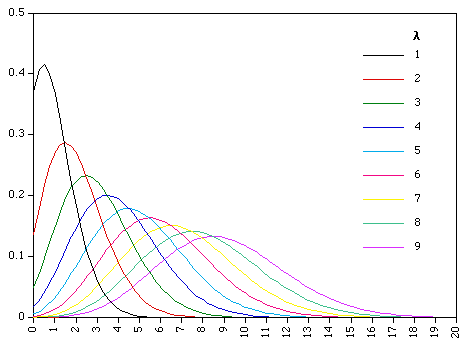
The probability that there are x occurences of an event (where x is a non-negative integer is given
by)

λ is often a rate per unit time, distance, or area. This is a discrete
distribution based on counting events. Note as you tend towards large λ (i.e.
long times) this
distribution becomes like a normal distribution.
This distribution arises as a consequence of the summation of many
rare events.
Examples of events governed by this distribution:
- The number of cars that pass through a certain point on a road during a given period of time.
- The number of spelling mistakes a secretary makes while typing a single page.
- The number of phone calls at a call center per minute
 Poisson statistics govern the behavior of queues!
Poisson statistics govern the behavior of queues!
- The number of roadkill found per unit length of road
- The number of pine trees per unit area of mixed forest.
- The number of soldiers killed by horse-kicks each year in each corps in the Prussian cavalry.
- The number of Cat 5 Hurricanes that pass by a given latitude
and longtitude
Some important assumptions
- arrivals/events occur one at a time (hence discrete)
- probability of an arrival/event in a given time interval depends only
on the length of the time interval
- the number of arrivals/events in non-overlapping times intervals are independent - that is
the arrival of the next event is not correlated with the fact that a previous event has
occurred. This is important. If this is not the case, then you can not use this statistical
approach.
Example:
Lollipops arrive to the lollipop tester on average every 10 minutes.
The arrival process is Poissonian.
What is the probability of 2 arrivals in the next 15 minutes?
So, x =2 (that's the number of events we are counting)
λ = 1.5 (we expect one per arrival every 10 minutes; total time = 15 minutes;
λ = 15/10 = 1.5)
P(x) = .251
What about 4 events?
P(x) = .047
|


 Poisson statistics govern the behavior of queues!
Poisson statistics govern the behavior of queues!